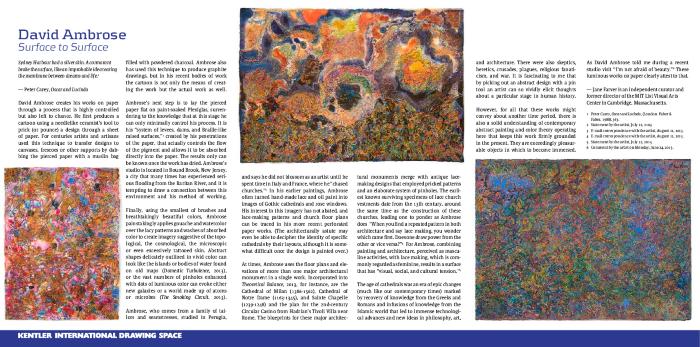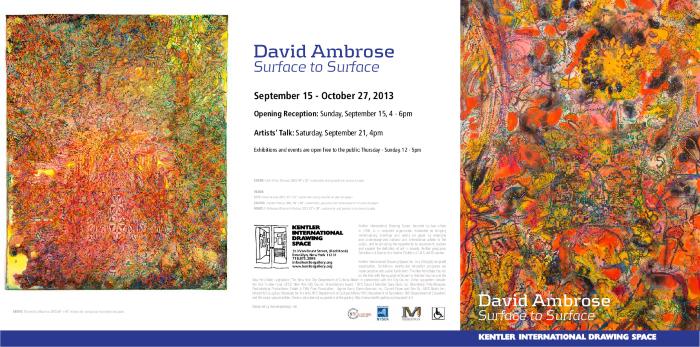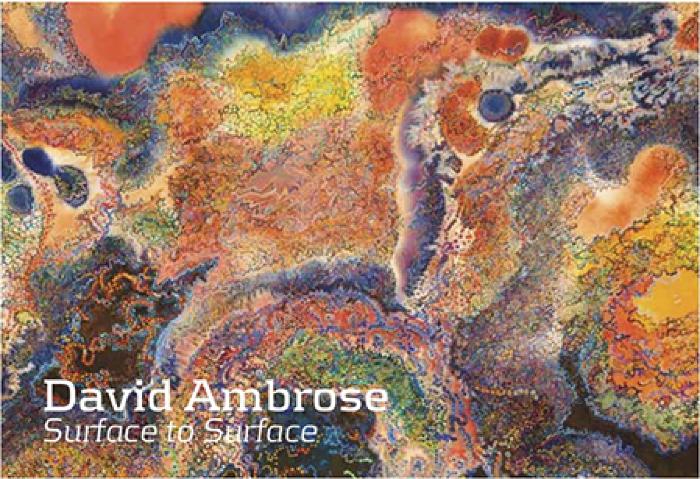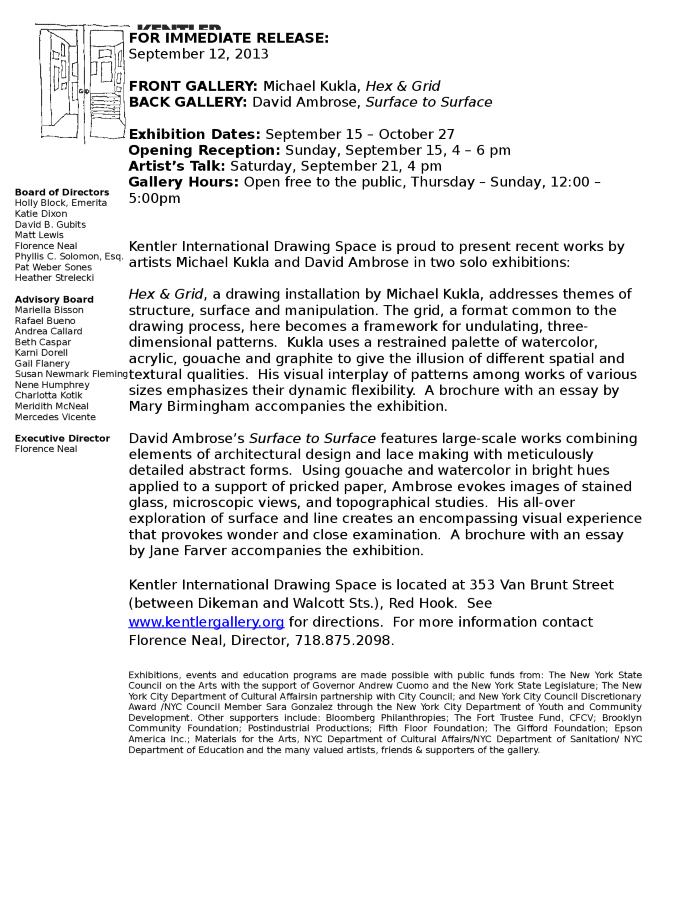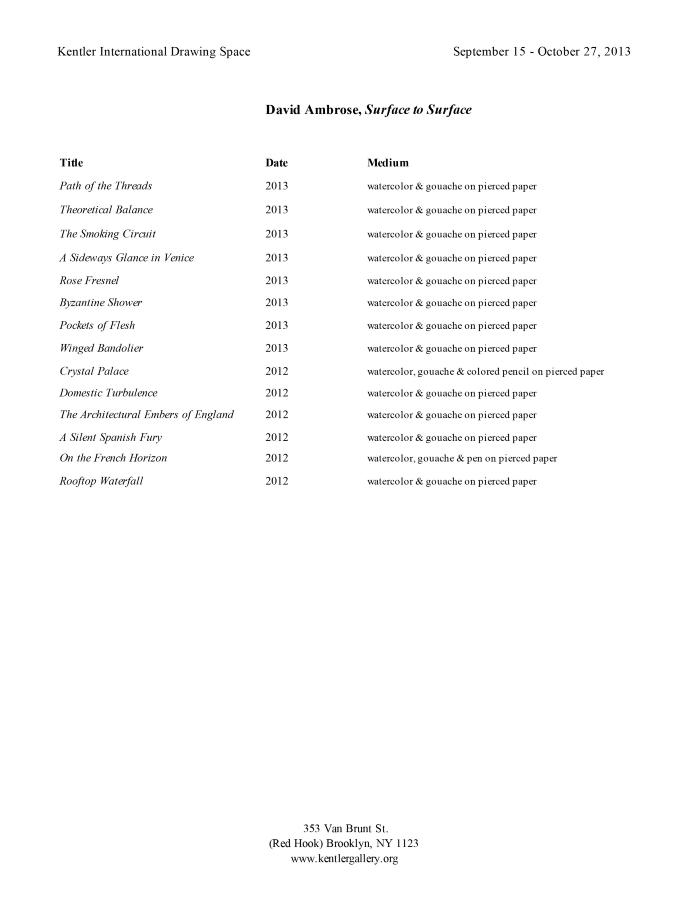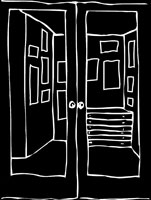exhibition
David Ambrose, Surface To Surface
Date
September 13 – October 27, 2013Opening Reception
September 13, 2013Essay By
Jane FarverArtist
David AmbroseRelated events
Poetry Reading: Charles Bernstein, Elaine Equi, Geoffrey YoungArtist's Talk: David Ambrose
exhibition Images
Click to Enlarge.
Press and Promotion
About the exhibition
Solo Exhibition (back space)
Artists' Talk: September 21, 2013
Sydney Harbour had a silver skin. A cormorant broke the surface, like an improbable idea tearing the membrane between dreams and life.1
— Peter Carey, Oscar and Lucinda
David Ambrose creates his works on paper through a process that is highly controlled but also left to chance. He first produces a cartoon using a needlelike ceramist’s tool to prick (or pounce) a design through a sheet of paper. For centuries artists and artisans used this technique to transfer designs to canvases, frescoes or other supports by dabbing the pierced paper with a muslin bag filled with powdered charcoal. Ambrose also has used this technique to produce graphite drawings, but in his recent bodies of work the cartoon is not only the means of creating the work but the actual work as well.
Ambrose’s next step is to lay the pierced paper flat on paint-soaked Plexiglas, surrendering to the knowledge that at this stage he can only minimally control his process. It is his “system of levees, dams, and Braille-like raised surfaces,”2 created by his penetrations of the paper, that actually controls the flow of the pigment and allows it to be absorbed directly into the paper. The results only can be known once the work has dried. Ambrose’s studio is located in Bound Brook, New Jersey, a city that many times has experienced serious flooding from the Raritan River, and it is tempting to draw a connection between this environment and his method of working.
Finally, using the smallest of brushes and breathtakingly beautiful colors, Ambrose painstakingly applies gouache and watercolor over the lacy patterns and washes of absorbed color to create imagery suggestive of the topological, the cosmological, the microscopic or even excessively tattooed skin. Abstract shapes delicately outlined in vivid color can look like the islands or bodies of water found on old maps (Domestic Turbulence, 2013), or the vast numbers of pinholes enhanced with dots of luminous color can evoke either new galaxies or a world made up of atoms or microbes (The Smoking Circuit, 2013).
Ambrose, who comes from a family of tailors and seamstresses, studied in Perugia, and says he did not blossom as an artist until he spent time in Italy and France, where he “chased churches.”3 In his earlier paintings, Ambrose often turned hand-made lace and oil paint into images of Gothic cathedrals and rose windows. His interest in this imagery has not abated, and lace-making patterns and church floor plans can be traced in his more recent perforated paper works. (The architecturally astute may even be able to decipher the identity of specific cathedrals by their layouts, although it is somewhat difficult once the design is painted over.)
At times, Ambrose uses the floor plans and elevations of more than one major architectural monument in a single work. Incorporated into Theoretical Balance, 2013, for instance, are the Cathedral of Milan (1386-1562), Cathedral of Notre Dame (1163-1345), and Sainte Chapelle (1239-1248) and the plan for the 2nd-century Circular Casino from Hadrian’s Tivoli Villa near Rome. The blueprints for these major architectural monuments merge with antique lacemaking designs that employed pricked patterns and an elaborate system of pinholes. The earliest known surviving specimens of lace church vestments date from the 13th century, around the same time as the construction of these churches, leading one to ponder as Ambrose does: “When you find a repeated pattern in both architecture and say lace making, you wonder which came first. Does one draw power from the other or vice versa?”4 For Ambrose, combining painting and architecture, perceived as masculine activities, with lace making, which is commonly regarded as feminine, results in a surface that has “visual, social, and cultural tension.”5
The age of cathedrals was an era of epic changes (much like our contemporary times) marked by recovery of knowledge from the Greeks and Romans and infusions of knowledge from the Islamic world that led to immense technological advances and new ideas in philosophy, art, and architecture. There were also skeptics, heretics, crusades, plagues, religious fanaticism, and war. It is fascinating to me that by picking out an abstract design with a pin tool an artist can so vividly elicit thoughts about a particular stage in human history.
However, for all that these works might convey about another time period, there is also a solid understanding of contemporary< abstract painting and color theory operating here that keeps this work firmly grounded in the present. They are exceedingly pleasurable objects in which to become immersed. As David Ambrose told me during a recent studio visit “I’m not afraid of beauty.”6 These luminous works on paper clearly attest to that.
— Jane Farver is an independent curator and former director of the MIT List Visual Arts Center in Cambridge, Massachusetts.
1 Peter Carey, Oscar and Lucinda, (London: Faber &
Faber, 1988), 363.
2 Statement by the artist, July 22, 2103.
3 E-mail correspondence with the artist, August 12, 2013.
4 E-mail correspondence with the artist, August 12, 2013.
5 Statement by the artist, July 22, 2013.
6 Comment by the artist on Monday, June 24, 2013.
